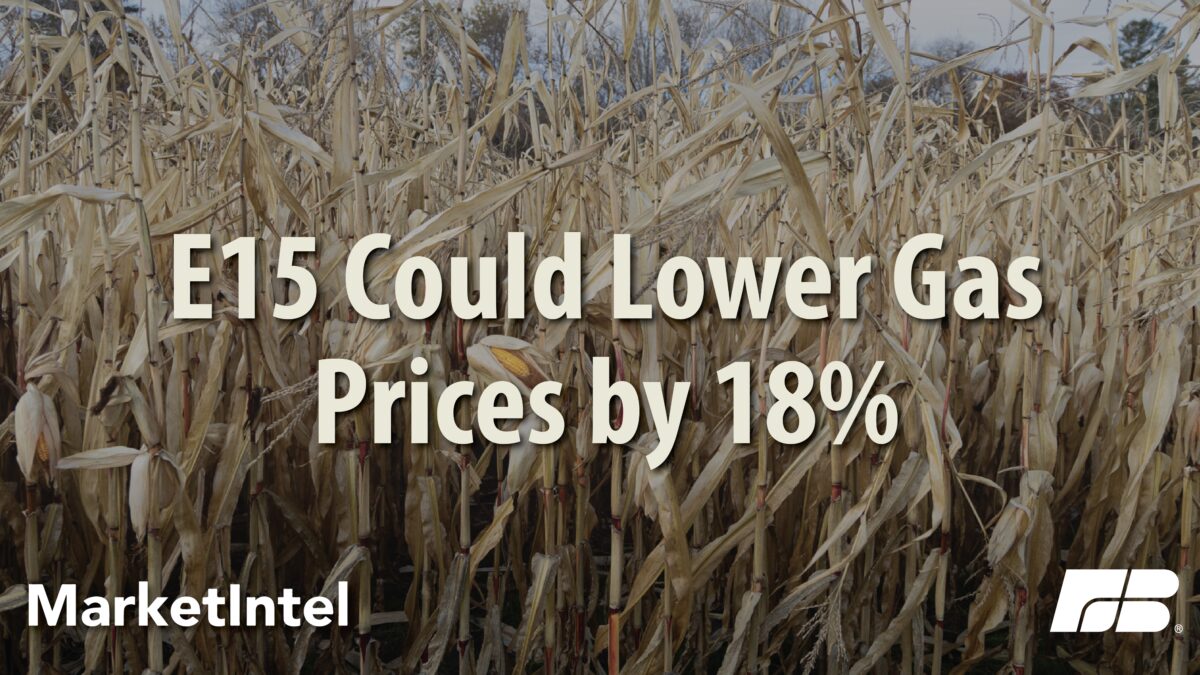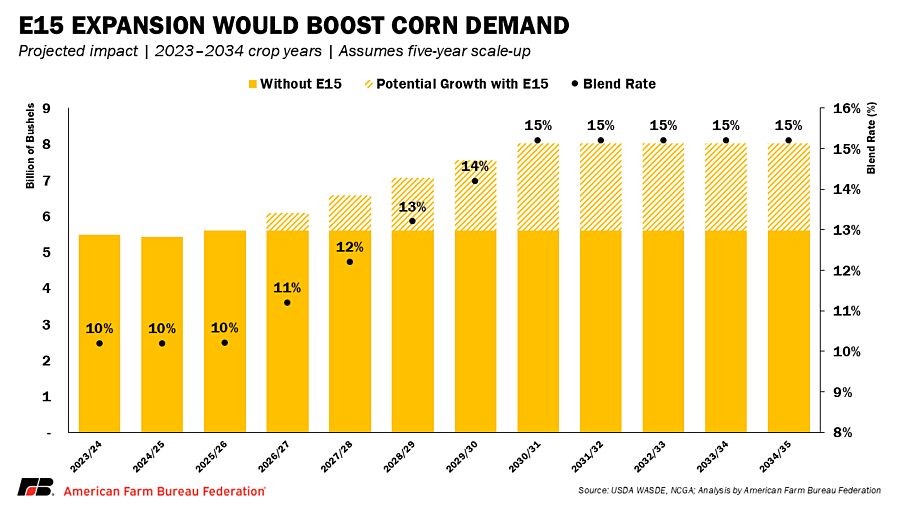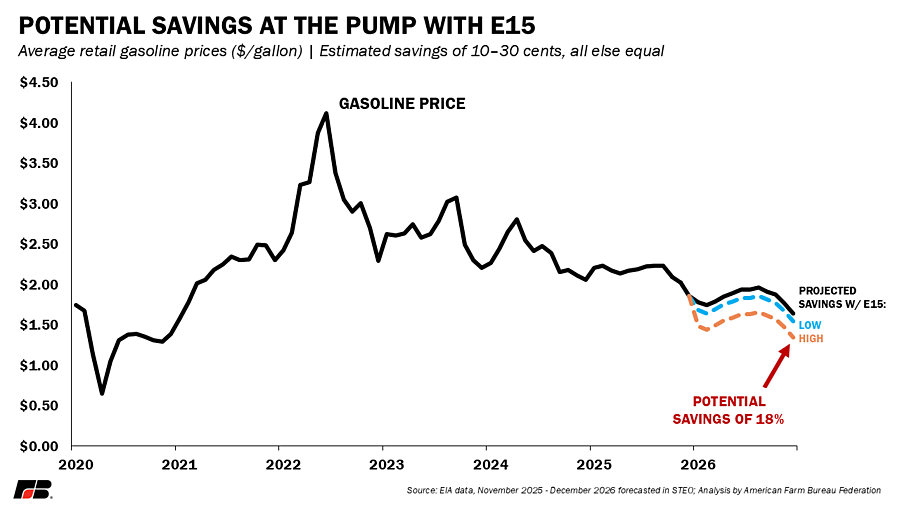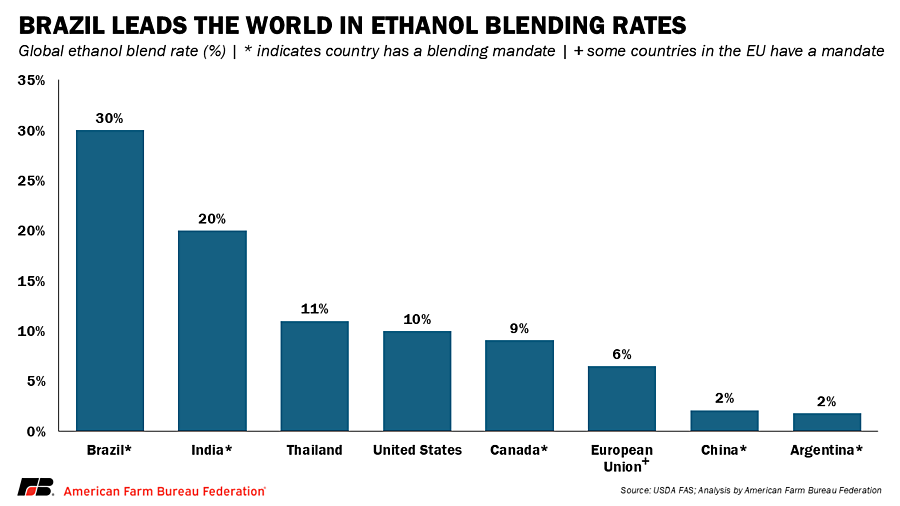E15: Boosting Corn Demand and Lowering Gas Prices

photo credit: AFBF
Faith Parum, Ph.D.
Economist
Farmers and ranchers face rising costs, weak prices and uneven global competition that threaten their livelihoods. At the same time, policy decisions in Washington can increase market access, spur demand and ensure fair competition. This new Market Intel series will examine six priority policy areas - trade, biofuels, whole milk in schools, interstate commerce, transparent input markets and prioritizing U.S.-grown produce - and how each can help strengthen the farm economy and rural communities.
In this article, the first of two exploring opportunities in biofuel markets, we examine permanent year-round E15 authorization. In the next installment, we will turn to the growing sustainable aviation fuel market, biodiesel, tax incentives that support biofuel production and the potential impact of small refinery exemptions on these evolving markets.
Few markets tie together energy security and farm profitability as closely as ethanol. For more than two decades, ethanol has provided a reliable outlet for U.S. corn, strengthened domestic fuel supplies and saved consumers money at the gas pump. Around the world, nations are turning to ethanol to bolster their own energy security, and global consumption has more than doubled since the early 2000s. This continued growth highlights the important role of American-made ethanol in meeting fuel demand.
The U.S. is forecasted to produce 61.6 billion liters of fuel ethanol and 18.6 billion liters of biodiesel and renewable diesel in 2025. Yet, as gasoline demand gradually declines due to more fuel-efficient and electric vehicles, expanding E15 (gasoline blended with 15% ethanol) use is key to keeping markets strong for U.S. corn producers and providing consumers with lower-cost fuel options. Policy decisions on year-round E15 sales will be pivotal in shaping the future of ethanol demand, keeping fuel prices affordable for consumers, and strengthening America’s energy independence. For corn producers, year-round E15 is essential to maintaining market stability and expanding future demand.
Ethanol
Ethanol currently uses about 5.6 billion bushels of corn each year, roughly 33% of total U.S. corn production. The standard gasoline blend contains 10% ethanol (E10), and in 2025 the national average blend reached about 10.2%. Some states, including top ethanol producers like Iowa and Minnesota, utilize higher blends such as E15 (15% ethanol) and E85 (85% ethanol) in flexible-fuel vehicles. However, the reach of these blends is limited by regulatory restrictions, particularly the seasonal limitation on E15 sales during the summer months.
E15 Uncertainty Stalls Growth
Each summer, federal limits on fuel volatility restrict the sale of E15 in many parts of the country. The rule stems from the Clean Air Act. In 1978, the EPA waived the requirements for E10 but left E15 subject to tighter standards even though it performs just as cleanly. E15 can reduce harmful tailpipe emissions by roughly 46% compared to non-ethanol gasoline, ethanol burns cleaner and represents a step toward more sustainable fuel consumption. To provide temporary relief, the Environmental Protection Agency has used emergency authority to issue nationwide waivers allowing summer E15 sales. In April 2025, EPA approved such a waiver for the second consecutive year. However, emergency waivers must be reissued each year, creating uncertainty for fuel retailers and consumers. Without a permanent policy, retailers are less likely to invest in E15 infrastructure and marketing.
This uncertainty comes as ethanol demand overall faces broader headwinds. The Energy Information Administration (EIA) projects that motor gasoline use will decline over the next decade, even under optimistic scenarios. National Corn Growers Association (NCGA) finds that if blend rates remain near a 10.5% average, domestic ethanol use could fall from about 14.2 billion gallons in 2025 to 13.1 billion gallons by 2035, roughly 400 million fewer bushels of corn used for ethanol. This reduction reflects the EIA’s forecast for lower U.S. motor gasoline consumption over the next decade, driven by more fuel-efficient vehicles, increased electric-vehicle adoption, and slower growth in overall driving miles.
Year-Round E15 Authorization Would Speed Up Demand
Nationwide, year-round E15 authorization presents the most straightforward path to preserve existing ethanol demand and create new growth. Even a modest increase in the national blend rate could have a measurable impact. According to NCGA, a 1% increase in the average ethanol blend rate would add 1.36 billion gallons of ethanol, equal to about 486 million bushels of corn. A 5% increase, to move from E10 to E15, would translate to 6.8 billion gallons of ethanol, or roughly 2.4 billion bushels of corn a year.
Pending congressional legislation, the “Nationwide Consumer and Fuel Retailer Choice Act of 2025”, would authorize year-round E15 sales in all 50 states, eliminating annual uncertainty and giving retailers the confidence to expand availability. Over 3,000 fuel stations already offer E15, and all major automakers now warranty the use of E15 in new vehicles. While E15 has strong potential to become the standard gasoline blend, significant investment in fueling infrastructure is still needed to make it widely available nationwide.
E15 Provides Extra Wallet Mileage to Consumers
Consumers benefit as well. E15 is typically 10 to 30 cents per gallon cheaper than regular gasoline, offers higher octane for improved engine performance, and reduces emissions of carbon monoxide and particulates. This would save consumers up to 18% at the pump.
In a global context, the U.S. lags behind major ethanol-producing countries in blend requirements. Brazil mandates a 27% to 30% ethanol blend in gasoline and widely uses flex-fuel vehicles. India plans to implement a 20% ethanol blend (E20) by 2025. A permanent national E15 standard would align the U.S. with international biofuel strategies, support domestic agriculture, and enhance energy independence.
Looking Ahead
Biofuels are one of the most reliable engines of demand for U.S. agriculture, supporting crop prices, rural jobs and energy independence. Authorizing year-round E15 sales offers the clearest near-term path to strengthening ethanol demand, potentially using an additional 2.4 billion bushels of corn each year while lowering gas prices by 10 to 30 cents per gallon.
Top Issues
VIEW ALL



